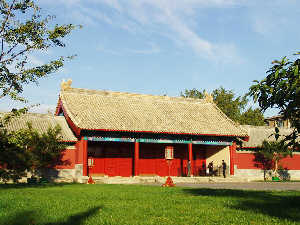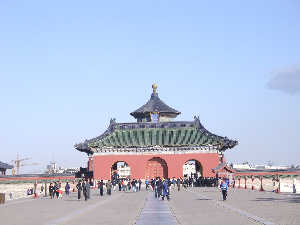 The rise and fall of the Divine Music Administration
The rise and fall of the Divine Music Administration
The Divine Music Administration was responsible for the divine music performances in the heaven-worshipping ceremonies. All the officials, musicians and dancers were Taoists - not regular Taoists who devote all their time to studying the sutra, but Chinese classical and folk music experts.
As well as preparing the twice-yearly performances, the Taoists developed two other interests - gardening and pharmacy. Gradually, the Divine Music Administration became one of the busiest temple fairs in Beijing until the beginning of theQing Dynasty.

The Divine Music Administration's most famous medicine was the herb motherwort (Yi Mu Cao). The soil around the Temple of Heaven is very suitable for growing of this herb. Many medicine shops were built and the practitioners became wealthy. With the improvement of processing skills, the Taoists began to export motherwort and it became one of China's earliest export commodities.
After the fall of the Qing Dynasty, Yuan Shikai dismissed the Taoists and closed their shops, allowing motherwort to be collected only in the autumn. This led to decline of the motherwort trade and the Divine Music Administration.
 The Emperors' enormouslanternsof worship
The Emperors' enormouslanternsof worship
To the west of the Zhao Xiang Gate (the South Heaven Gate of the Temple of Heaven), stand three big stone daises called Wang Deng Tai (roughly 'lantern viewing platforms'). Each dais has a pole called a Wang Deng Gan built in 1530 to hang lanterns for early morning ceremonies. The lanterns were used only by the emperor and were made according to specific measurements. In traditional Chinese culture, the number nine means noble and powerful and could only be used by emperors. So the length of the Wang Deng Gan is 9 zhang 9 chi 9 cun (one zhang is 3.3 m, one chi is 33 cm and one cun is 3.3 cm).

The lanterns hanging on the Wang Deng Gan are much bigger than ordinary ones. They are about two meters wide and two and a half meters high - almost as big as a small room. The lanterns' skeletons are made of wire with yellow cotton fabric pasted over. Candles were placed on the wooden bases, lit and lanterns fitted on top. The candles used were made of yellow wax given as tribute by Yunnan andSichuan provinces, and processed by the Imperial Household Department (Nei Wu Fu). The candles were 1.3 m high and up to 33cm wide with a loong imperialdragonrepresenting luck and fortune carved into them. These extremely expensive candles could burn for 12 hours without needing to be trimmed or have oil added.
